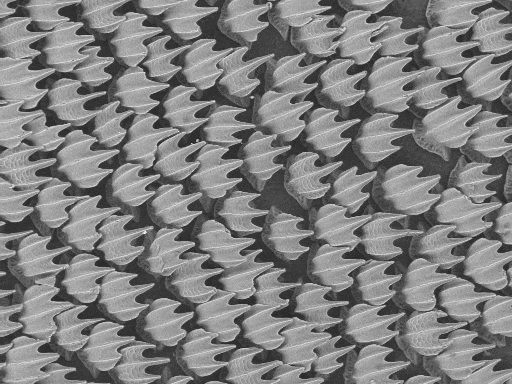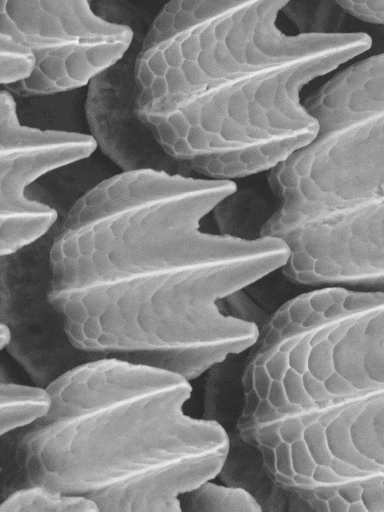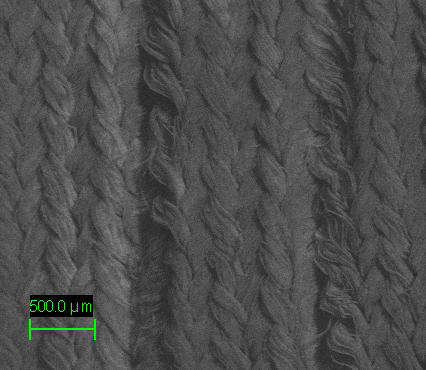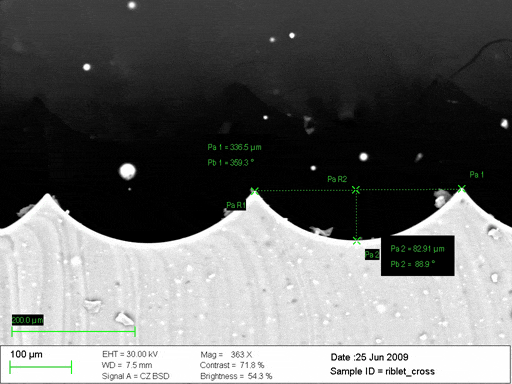Fish Biomechanics & Hydrodynamics
(Including Shark Skin Function)
The topic of fish biomechanics and hydrodynamics encompasses much of the work that we do in the lab. We have analyzed all fins, as well as body and tail function, in a diversity of species including hagfish; sharks; rays; sturgeon; eels; trout; and a diversity of spiny-finned fishes—most notably the bluegill sunfish.
Our past research includes:
- Analyses of the kinematics of fish locomotion
- Study of the electrical activity of muscles that produce locomotor movements
- Analyses of the material properties of fish fin tissues
- Hydrodynamic study of water flow over the body and fins and in the wake of swimming fishes
Work in the lab is primarily experimental; we study both live fishes and a diversity of robotic models of body and finned swimming. We have also undertaken a significant number of collaborative studies with colleagues who are expert in computational fluid dynamic modeling. Recently, our work in the laboratory has expanded to include understanding the complex skin structure of sharks and how it functions in locomotion. Shark skin has inspired a variety of man-made materials including the Speedo full body suits used by competitive swimmers, and riblet materials used on sailboats and wind turbine blades. In a February 2012 paper, we showed that the denticles which comprise the surface of a shark’s skin may not only reduce drag, but could also enhance thrust during swimming. For the same paper, we studied the ability of the Speedo Fastskin® FSII material and a silicone riblet material to improve swimming speed.

Skin surface from the mid-body region of a bonnethead shark (Sphyrna tiburo). This image shows the denticles or scales on the surface of the skin. Each denticle is approximately 100 microns in diameter. Printer paper thickness is also around 100 microns, so each denticle is quite small! Denticles are made of enamel and dentine, and are very similar in microstructure to a human tooth. Photo credit: J. Oeffner and G. V. Lauder. 
Same as the image on the left but a close view of the denticle structure. Photo credit: J. Oeffner and G. V. Lauder. 
“Biomimetic” surface of Speedo Fastskin® FS II fabric. Photo credit: J. Oeffner and G. V. Lauder. 
Cross-section of silicone riblet material (manufactured in our lab). Photo credit: J. Oeffner and G. V. Lauder.
See papers in the Download Reprints section for more on this topic, especially: 2008. Tytell, E. D. and G. V. Lauder. Hydrodynamics of the escape response in bluegill sunfish, Lepomis macrochirus. Journal of Experimental Biology 211: 3359-3369. 2009. Flammang, B. E. and G. V. Lauder. Caudal fin shape modulation and control during acceleration, braking, and backing manuevers in bluegill sunfish, Lepomis macrochirus. Journal of Experimental Biology 212: 277-286. 2010. Carlson, R. L. and G. V. Lauder. Living on the bottom: kinematics of benthic station-holding in darter fishes (Percidae: Etheostomatinae). Journal of Morphology 271:25-35. (Cover image) 2010. Tytell, E. D., Borazjani, I., Sotiropoulos, F., Baker, T. V., Anderson, E. J., and Lauder, G. V. Disentangling the functional roles of morphology and motion in fish swimming. Integrative and Comparative Biology 50: 1140-1154. 2011. Lauder, G. V. Swimming hydrodynamics: ten questions and the technical approaches needed to resolve them. Experiments in Fluids 51: 23-35. 2011. Carlson, R. L. and G. V. Lauder. Escaping the flow: boundary layer use by the darter Etheostoma tetrazonum (Percidae) during benthic station-holding. Journal of Experimental Biology 214: 1181-1193. 2011. Flammang, B. E., Lauder, G. V., Troolin, D. R., and Strand, T. Volumetric imaging of fish locomotion. Biology Letters 7:695-698. 2011. Flammang, B. E., G. V. Lauder, D. R. Troolin, and T. Strand. Volumetric imaging of shark tail hydrodynamics reveals a three-dimensional dual-ring vortex wake structure. Proc. Royal. Soc. London 278:3670-3678. 2011. Lauder, G. V., P. G. A. Madden, J. L. Tangorra, E. Anderson, and T. V. Baker. Bioinspiration from fish for smart material design and function. Smart Materials and Structures 20: 094014. 2012. Borazjani, I., Sotiropoulos, F., Tytell, E. D., and G. V. Lauder. On the hydrodynamics of the bluegill sunfish c-start escape response: three-dimensional simulations and comparison with experimental data. Journal of Experimental Biology 215: 671-684. 2012. Oeffner, J. and G. V. Lauder. The hydrodynamic function of shark skin and two biomimetic applications. Journal of Experimental Biology 215: 785-795. r vehicles. IEEE Journal of Oceanic Engineering 32(2): 533-550. 2010. Phelan, C., J. L. Tangorra, G. V. Lauder, and M. Hale. A biorobotic model of the sunfish pectoral fin for investigations of fin sensorimotor control. Bioinspiration and Biomimetics 5. DOI:10.1088/1748-3182/5/3/035003. 2010. Gottlieb, J.R., Tangorra, J.L., Esposito, C.J., and G.V. Lauder. A biologically derived pectoral fin for yaw turn maneuvers. Applied Bionic and Biomechanics 7:41-55. 2010. Tangorra, J.L., Lauder, G.V., Hunter, I.W., Mittal, R., Madden, P.G.A., and M. Bozkurttas. The effect of fin ray flexural rigidity on the propulsive forces generated by a biorobotic fish pectoral fin. Journal of Experimental Biology 213:4043-4054. 2011. Curet, O.M., Patankar, N.A., Lauder, G.V., and M.A. MacIver. Aquatic manoeuvering with counter-propagating waves: a novel locomotive strategy. Journal of the Royal Society Interface 8: 1041-1050. (Cover photo of this journal issue available.) 2011. Curet, O. M., Patankar, N. A., Lauder, G. V., and MacIver, M. A. Mechanical properties of a bio-inspired knifefish with an undulatory propulsor. Bioinspiration and Biomimetics 6: doi:10.1088/1748-3182/6/2/026004. 2011. Tangorra, J., Phelan, C., Esposito, C., and G.V. Lauder. Use of biorobotic models of highly deformable fins for studying the mechanics and control of fin forces in fishes. Integrative and Comparative Biology 51:176-189. 2011. Lauder, G.V., Lim, J., Shelton, R., Witt, C., Anderson, E.J., and Tangorra, J. Robotic models for studying undulatory locomotion in fishes. Marine Technology Society Journal 45: 41-55. 2012. Esposito, C.J., Tangorra, J.L., Flammang, B.E., and G.V. Lauder. A robotic fish caudal fin: effects of stiffness and motor program on locomotor performance. Journal of Experimental Biology 215: 56-67.